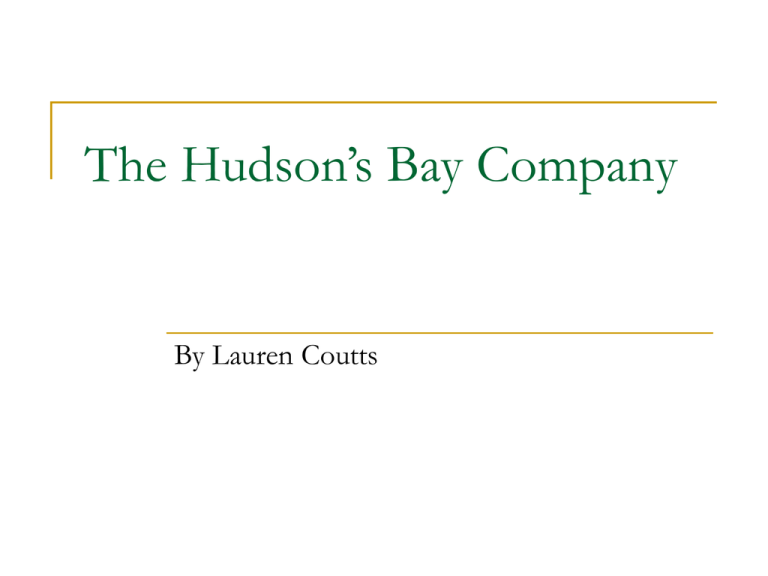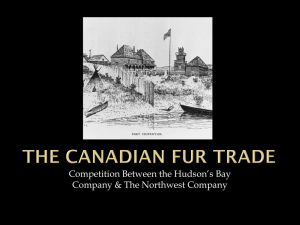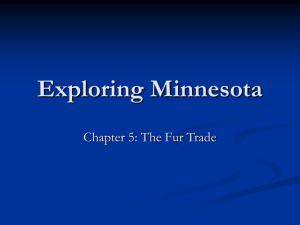The Hudson`s Bay Company
advertisement

The Hudson’s Bay Company By Lauren Coutts What is the Hudson’s Bay Company? The Hudson’s Bay Company is the oldest commercial company in North America and one of the oldest in the world The Hudson’s Bay Company started off during the fur trade in 1670 and is still a successful company today around the world The fur trade Since the beginning of time people have been trading animal furs to create pelts for protection Around the 1600’s, there was an increasing demand for beaver fur to create hats in Europe Beaver pelts created high quality felt which was resistant to water and very warm At one point, the beaver became virtually extinct in Europe because of the high demand for their fur which led European explorers to travel to North America in search of beavers The Europeans came in contact with the aboriginal peoples who traded their pelts. This fuelled the fur trade The beginning of the fur trade in Canada Contact between the Aboriginals in Canada and Europeans grew when Jacques Cartier sailed from France to North America in 1534 Cartier sailed on behalf of the king of France in search of gold and first reached the Atlantic Coast of Canada where he met the Mi’kmaq peoples The beginning of the fur trade in Canada The Mi’kmaq were eager to trade their furs with Cartier in exchange for European tools and inventions such as knives When Cartier travelled further inland, he discovered the Iroquois who also traded their furs Cartier claimed the land for France and the Tadoussac (St. Lawrence River) became the centre of trade for the French and aboriginal people The aboriginal peoples were vital to the fur trade because of their knowledge of fur-trapping and navigation of Canadian landscape which they passed on to the Europeans Samuel de Champlain In 1608, Samuel de Champlain realized potential trade opportunities and travelled to modern day Québec City in order to establish a perminant settlement Champlain wanted to bring the French over to Canada, and the King gave him permission provided that Champlain established the fur trade Samuel de Champlain sent his men to live among the Algonquin and Huron people in order to learn their culture and language It was part of his plan to strenghthen the bond between the French and aboriginal in order to keep the fur trade thriving because they depended on the aboriginal people’s resourses English vs French Shortly after Samuel de Champlain established a perminent French settlement in modern day Québec and started developping the fur trade, the English became interested in the potential for money from the fur trade Competition between the French and English was fierce England and France competed for control over the land and resources and shipped their beaver pelts back to Europe The competition between England and France also caused disputes among First Nations who took sides among England and France. Many wars between the French and Wendat against th English and Iroquois took place and the disputes lasted over 90 years, almost putting an end to the fur trade The Hudson Bay Meanwhile, over serveral years, explorers Martin Frobisher, John Davis, and Henry Hudson explored the Atlantic searching for a Northwest Passage In 1610, Explorer Henry Hudson came across a bay which was named after himself: Hudson Bay This marked an important day in Canadian History and the fur trade Médard Chouart des Groseilliers and Pierre Radisson Médard Chouart des Groseilliers and Pierre Radisson were two french courieurs de bois (fur traders who gathered fur from the woods and traded with the First Nations) who brought the fur trade back to life During their travels, the two men met the Sioux who told them about the abundant amount of beavers up north near the Hudson Bay Coming back from the Hudson Bay, they had thousands of beavers which were taken away because the two men didn’t have rights to the lands The two men could not get financial support for their expeditions from the American or French so they started working for the English In 1665, they met with the king of England, King Charles II who supported their expeditions to collect furs The Hudson's Bay Company is formed Prince Rupert, the cousin of King Charles II, aquired the Royal Charter giving permission to the land around the Hudson Bay to the Governor and Company of Adventurers of England trading into Hudson Bay This gave Médard Chouart des Groseilliers and Pierre Radisson the permission to hunt beavers in the lands of the Hudson Bay for King Henry II This was the foundation of the Hudson’s Bay Company The Governor and Company of Adventurers of England Trading into Hudson's Bay The charter giving King Charles II the rights to the land around the Hudson Bay were incorporated on May 2nd 1670 The royal charter given to the Governor and Company of Adventurers of England Trading into the Hudson Bay gave the company a monopoly over the fur trade The area was named Rupert’s Land after Prince Rupert This region that King Charles II owned rights to consisted of (3.9 million km²) and was 1/3 of the size of Canada today and also included parts of the United States Rupert's Land was the largest purchase of land in the 1800s The beginning of The Hudson Bay Company The headquarters of the Hudson’s Bay Company was established in Fort Nelson which is in present day northeastern Manitoba The Business was booming from 1714 until the late 1740s bringing back profits to England The Hudson's Bay Company had no competition since they were the only company aloud to trade fur The company built posts all along the Hudson Bay in present day Manitoba, Ontario, and Québec and eventually began creating “factories” inland The First Nations and Métis peoples did most of the animal trapping and pelt preparation for the Hudson’s Bay Company Conflict for the Hudson’s Bay Company The success of the Hudson’s Bay Company began to slow down around the 1750’s due to the Seven Years War, a war between England and France battling over land in Canada Eventually Britain won back most of the land that France had taken over also taking over New France After the war had ended, The Hudson’s Bay Company had new competition from North West Company in Montréal The North West Company was formed by former French coureurs de bois in 1783 who had no one to work for after Britain won New France Hudson’s Bay Company vs. North West Company After the Hudson’s Bay company had a monopoly over the fur trade for so long, eventually the North West Company became a strong competition A rivalry formed between the two companies trying to have control over the fur trade Around the 1800’s, a war began between the two companies They began to explore farther west in order to find new trading partners, traveling to Edmonton and Calgary and establishing trading posts After years of war, the North West Company was defeated and in 1821, it merged into the Hudson’s Bay Company There was now no competition and the company experienced success once again Years of power and change After merging with The North West Company, HBC owned most of the land in Canada and was the most powerful company in North America In 1821, HBC started trading their furs from other countries New technologies in treating fur made the need for beaver less necessary Different types of animals were now being used for cheaper and silk hats were becoming fashionable By 1840, the fur trade was shrinking and by 1870, it was no longer a major industry The beginning of the retail era In 1867, the Dominion of Canada was formed The government of Canada asked Britain for the rights over Rupert’s land in fear that the Americans would take over the land in the west The HBC signed the Deed of Surrender in 1869, signing most of their land over to the British Crown which granted the land to Canada in exchange for money and some of the land This started the retail era for the HBC, since the fur trade had collapsed The company started a new business selling land to the farmers, settlers and developers They also provided supplies for the settlers in the West and opened its first retail store in Winnipeg, Manitoba in 1881 Hudson’s Bay Company Today Most of the Hudson’s Bay Company stores were in Western Canada until the 1960’s when the company bought several chains in Montreal and shortened their name to the Bay This led to the expansion to Eastern Canada By 1978, it was the largest chain store in Canada Around the 1980’s, the Bay bought several retail stores including Zellers, Simpsons, Fields, Robinson’s, Home Outfitters and many more The Bay was still involved in the fur trade up until 1991, when it sold the last of its trading posts It is now a chain of over 90 department stores across Canada and is North America’s oldest company Bibliography http://firstpeoplesofcanada.com/fp_furtrade/fp_f urtrade3.html http://www.canadiana.ca/hbc/hist/hist6_e.html http://www2.hbc.com/hbc/history/










